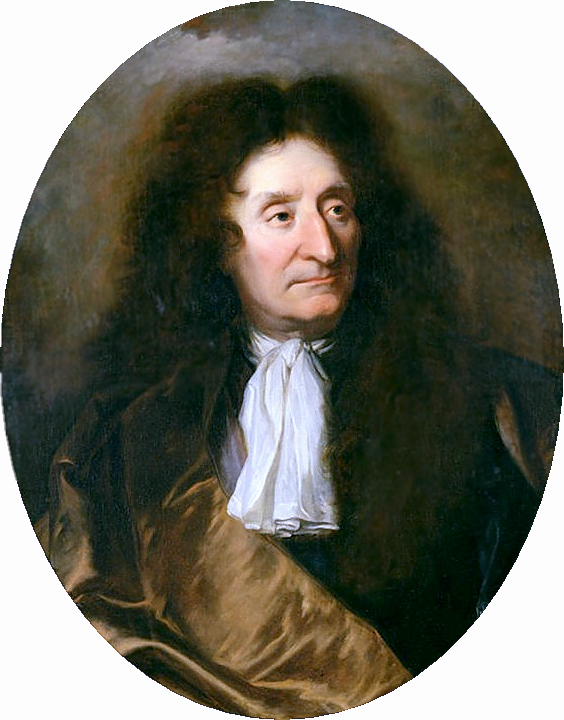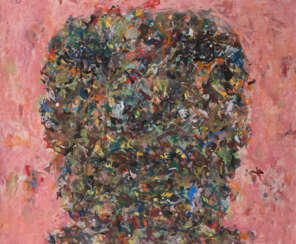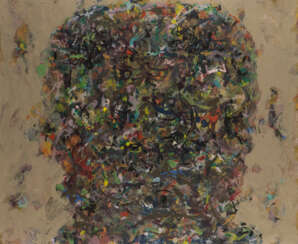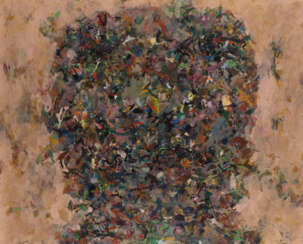mures

Anca Mureșan is a Romanian artist living and working in Bucharest and Düsseldorf.
Her style has a wide expressive palette, from post-impressionism to neo-Dadaist interventions or conceptualist concentrations.
Mureșan has developed a unique exhibition project, turning an entire gallery into a single painting. She painted entirely in the H'art Gallery, where she usually exhibits her work. The gallery space became a painting-the walls, the ceiling, the floor, the gallerist's office, the doors. Inspired by this achievement in Bucharest, Anca Mureșan suggests a similar endeavor in other galleries.


Anca Mureșan is a Romanian artist living and working in Bucharest and Düsseldorf.
Her style has a wide expressive palette, from post-impressionism to neo-Dadaist interventions or conceptualist concentrations.
Mureșan has developed a unique exhibition project, turning an entire gallery into a single painting. She painted entirely in the H'art Gallery, where she usually exhibits her work. The gallery space became a painting-the walls, the ceiling, the floor, the gallerist's office, the doors. Inspired by this achievement in Bucharest, Anca Mureșan suggests a similar endeavor in other galleries.


Anca Mureșan is a Romanian artist living and working in Bucharest and Düsseldorf.
Her style has a wide expressive palette, from post-impressionism to neo-Dadaist interventions or conceptualist concentrations.
Mureșan has developed a unique exhibition project, turning an entire gallery into a single painting. She painted entirely in the H'art Gallery, where she usually exhibits her work. The gallery space became a painting-the walls, the ceiling, the floor, the gallerist's office, the doors. Inspired by this achievement in Bucharest, Anca Mureșan suggests a similar endeavor in other galleries.


Anca Mureșan is a Romanian artist living and working in Bucharest and Düsseldorf.
Her style has a wide expressive palette, from post-impressionism to neo-Dadaist interventions or conceptualist concentrations.
Mureșan has developed a unique exhibition project, turning an entire gallery into a single painting. She painted entirely in the H'art Gallery, where she usually exhibits her work. The gallery space became a painting-the walls, the ceiling, the floor, the gallerist's office, the doors. Inspired by this achievement in Bucharest, Anca Mureșan suggests a similar endeavor in other galleries.


Anca Mureșan is a Romanian artist living and working in Bucharest and Düsseldorf.
Her style has a wide expressive palette, from post-impressionism to neo-Dadaist interventions or conceptualist concentrations.
Mureșan has developed a unique exhibition project, turning an entire gallery into a single painting. She painted entirely in the H'art Gallery, where she usually exhibits her work. The gallery space became a painting-the walls, the ceiling, the floor, the gallerist's office, the doors. Inspired by this achievement in Bucharest, Anca Mureșan suggests a similar endeavor in other galleries.


Anca Mureșan is a Romanian artist living and working in Bucharest and Düsseldorf.
Her style has a wide expressive palette, from post-impressionism to neo-Dadaist interventions or conceptualist concentrations.
Mureșan has developed a unique exhibition project, turning an entire gallery into a single painting. She painted entirely in the H'art Gallery, where she usually exhibits her work. The gallery space became a painting-the walls, the ceiling, the floor, the gallerist's office, the doors. Inspired by this achievement in Bucharest, Anca Mureșan suggests a similar endeavor in other galleries.


Anca Mureșan is a Romanian artist living and working in Bucharest and Düsseldorf.
Her style has a wide expressive palette, from post-impressionism to neo-Dadaist interventions or conceptualist concentrations.
Mureșan has developed a unique exhibition project, turning an entire gallery into a single painting. She painted entirely in the H'art Gallery, where she usually exhibits her work. The gallery space became a painting-the walls, the ceiling, the floor, the gallerist's office, the doors. Inspired by this achievement in Bucharest, Anca Mureșan suggests a similar endeavor in other galleries.


Anca Mureșan is a Romanian artist living and working in Bucharest and Düsseldorf.
Her style has a wide expressive palette, from post-impressionism to neo-Dadaist interventions or conceptualist concentrations.
Mureșan has developed a unique exhibition project, turning an entire gallery into a single painting. She painted entirely in the H'art Gallery, where she usually exhibits her work. The gallery space became a painting-the walls, the ceiling, the floor, the gallerist's office, the doors. Inspired by this achievement in Bucharest, Anca Mureșan suggests a similar endeavor in other galleries.


Anca Mureșan is a Romanian artist living and working in Bucharest and Düsseldorf.
Her style has a wide expressive palette, from post-impressionism to neo-Dadaist interventions or conceptualist concentrations.
Mureșan has developed a unique exhibition project, turning an entire gallery into a single painting. She painted entirely in the H'art Gallery, where she usually exhibits her work. The gallery space became a painting-the walls, the ceiling, the floor, the gallerist's office, the doors. Inspired by this achievement in Bucharest, Anca Mureșan suggests a similar endeavor in other galleries.


Anca Mureșan is a Romanian artist living and working in Bucharest and Düsseldorf.
Her style has a wide expressive palette, from post-impressionism to neo-Dadaist interventions or conceptualist concentrations.
Mureșan has developed a unique exhibition project, turning an entire gallery into a single painting. She painted entirely in the H'art Gallery, where she usually exhibits her work. The gallery space became a painting-the walls, the ceiling, the floor, the gallerist's office, the doors. Inspired by this achievement in Bucharest, Anca Mureșan suggests a similar endeavor in other galleries.


Anca Mureșan is a Romanian artist living and working in Bucharest and Düsseldorf.
Her style has a wide expressive palette, from post-impressionism to neo-Dadaist interventions or conceptualist concentrations.
Mureșan has developed a unique exhibition project, turning an entire gallery into a single painting. She painted entirely in the H'art Gallery, where she usually exhibits her work. The gallery space became a painting-the walls, the ceiling, the floor, the gallerist's office, the doors. Inspired by this achievement in Bucharest, Anca Mureșan suggests a similar endeavor in other galleries.


Anca Mureșan is a Romanian artist living and working in Bucharest and Düsseldorf.
Her style has a wide expressive palette, from post-impressionism to neo-Dadaist interventions or conceptualist concentrations.
Mureșan has developed a unique exhibition project, turning an entire gallery into a single painting. She painted entirely in the H'art Gallery, where she usually exhibits her work. The gallery space became a painting-the walls, the ceiling, the floor, the gallerist's office, the doors. Inspired by this achievement in Bucharest, Anca Mureșan suggests a similar endeavor in other galleries.



Rosa Schweninger is an Austrian artist, a member of a Viennese family of artists that included her father, Karl Schweninger the Elder, and her brother, Karl Schweninger the Younger. Rosa's work includes portraits and floral compositions.





Tristan Tzara, originally named Sami (Samuel) Rosenstock, was a Romanian and French artist and writer best known as a founding figure of the Dada movement. Born in 1896 in Moinești, Romania, Tzara's influence extends across poetry, performance, and manifesto writing, marking him as a pivotal personality in 20th-century art and culture. His work challenged conventional norms and sought to disrupt the traditional boundaries of art, making him a central figure in the avant-garde community.
Dada, the movement with which Tzara is most closely associated, emerged as a reaction against the horrors of World War I, advocating for irrationality and anti-bourgeois protest. Tzara's contributions, including his manifestos, poetry, and performances, were instrumental in shaping Dada's legacy. His art and writings emphasized the importance of spontaneity and chaos, challenging the status quo and the very definition of art itself. Tzara's approach was not confined to a single medium; he explored poetry, playwriting, and critical theory, leaving a diverse and impactful body of work.
Though Tzara is not widely known for sculpture or painting in the traditional sense, his influence on these and other art forms is undeniable. His work and ideas laid the groundwork for later avant-garde movements, including Surrealism. While specific works of Tzara in museums or galleries were not detailed in the research, his legacy is preserved through the collections of major institutions worldwide, reflecting his enduring impact on the arts.
For collectors and experts in art and antiques, understanding Tzara's contributions provides insight into the radical shifts in culture and art in the early 20th century. His work remains a testament to the power of art to challenge, provoke, and transform. To stay informed about new product sales and auction events related to Tristan Tzara, sign up for our updates. This subscription ensures you're alerted to unique opportunities to engage with the history and legacy of a key figure in modern art.

Alberto Giacometti was a Swiss sculptor, painter, draftsman, and printmaker, renowned for his distinctive elongated sculptures of solitary figures. Born in Borgonovo, Switzerland, in 1901, into a family of artists, Giacometti's talent was evident from an early age, encouraged by his father, Giovanni, a post-Impressionist painter, and his godfather, Cuno Amiet, a Fauvist painter. Moving to Paris in 1922 to study under the sculptor Antoine Bourdelle, Giacometti became a pivotal figure in Surrealism before focusing intensely on the human form, leading to his signature style of thin, elongated figures that evoke feelings of solitude and existential dread.
Giacometti's work spans several decades and various phases, including his early involvement with Surrealism and his later, more recognized existential and figurative sculptures. Notably, his sculptures, such as "Walking Man I" and "The Palace at 4 a.m.," reflect his unique view of reality and his relentless pursuit to capture the human essence. His approach was influenced by his associations with prominent figures of the art world, including Miró and Picasso, and intellectuals like Jean-Paul Sartre.
Despite facing challenges, including periods of self-doubt and the physical toll on his health, Giacometti's legacy as a master sculptor and artist remains influential. His works are celebrated worldwide and featured in major museums, such as the Museum of Modern Art in New York and the Tate Gallery in London, testament to his enduring impact on the art world.
Collectors and experts in art and antiques continue to revere Giacometti's work for its emotional depth and unique aesthetic. For those interested in the pioneering spirit of modern sculpture, Alberto Giacometti's oeuvre offers a profound exploration of the human condition and the artist's relentless pursuit of reality through art.
To stay updated on sales and auction events related to Alberto Giacometti's work, sign up for updates. This subscription is an excellent opportunity for collectors and enthusiasts to remain informed about new discoveries and opportunities related to Giacometti's enduring legacy.






















































![LA PÉROUSE, Jean-François de Galaup, comte de (1741-1788). Voyage de La Pérouse autour du monde, publié conformément au décret du 22 avril 1791. Paris : imprimerie de la République, an V [1797].Édition originale du célèbre voyage de La Pérouse, à bord de](/assets/image/picture_1431273/64893/d78c32cd8befba20bc150009de2a538d1620043200jpg__fix_374_244.jpeg)
![LA PÉROUSE, Jean-François de Galaup, comte de (1741-1788). Voyage de La Pérouse autour du monde, publié conformément au décret du 22 avril 1791. Paris : imprimerie de la République, an V [1797].Édition originale du célèbre voyage de La Pérouse, à bord de](https://veryimportantlot.com/assets/image/picture_1431273/64893/d78c32cd8befba20bc150009de2a538d1620043200jpg__fix_374_244.jpeg)




![[MAINERI, Maino de’ (M. 1368) -- Arnaud de VILLENEUVE (pseud-, vers 1240-1311) - REGIMEN SANITATIS SALERNITANUM].](/assets/image/picture_2734924/da8b6/9078c799efae77bf9d515bbae9863c091679526000jpg__fix_374_244.jpeg)
![[MAINERI, Maino de’ (M. 1368) -- Arnaud de VILLENEUVE (pseud-, vers 1240-1311) - REGIMEN SANITATIS SALERNITANUM].](https://veryimportantlot.com/assets/image/picture_2734924/da8b6/9078c799efae77bf9d515bbae9863c091679526000jpg__fix_374_244.jpeg)
![[GRIMOD DE LA REYNIÈRE, Alexandre-Balthazar-Laurent (1758-1837)].](/assets/image/picture_2734961/a9983/04b428f443deb8cdd61c9e64233fdf791679526000jpg__fix_374_244.jpeg)
![[GRIMOD DE LA REYNIÈRE, Alexandre-Balthazar-Laurent (1758-1837)].](https://veryimportantlot.com/assets/image/picture_2734961/a9983/04b428f443deb8cdd61c9e64233fdf791679526000jpg__fix_374_244.jpeg)







